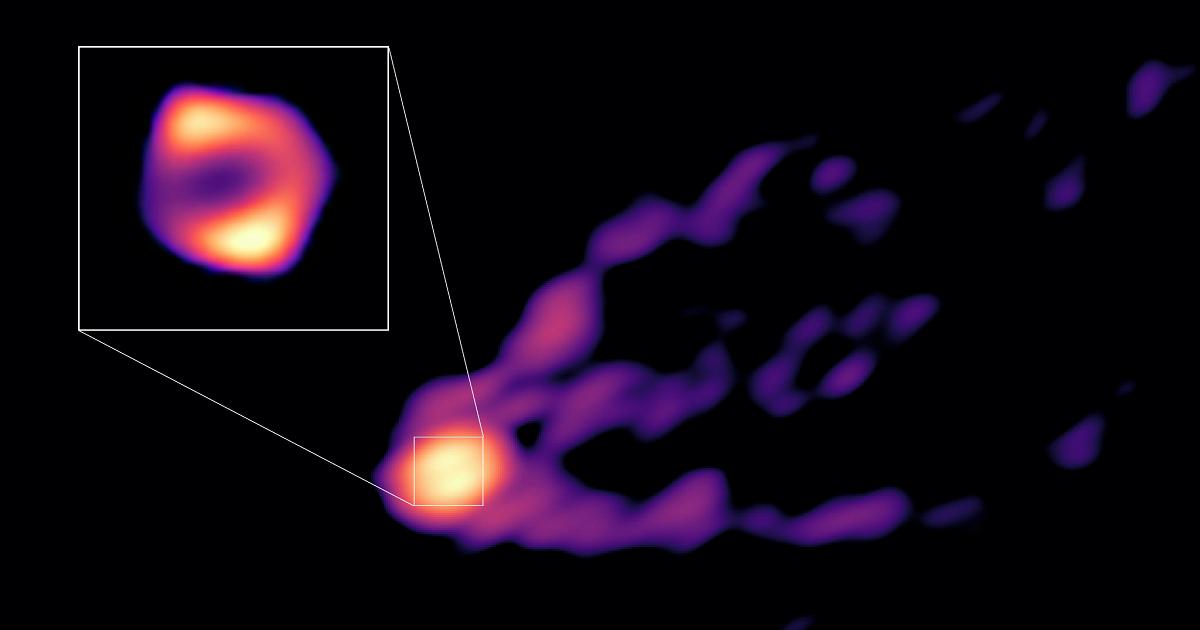Science and technology
INAF researchers also participated in the study
Space. Here is the first direct image of a black hole ejecting a powerful jet of plasma
For the first time astronomers have observed, in the same image, the jet emerging from the black hole at the center of the galaxy Messier 87 and its "shadow".
27/04/2023
An international team of scientists, including researchers from the National Institute of Astrophysics (INAF) has managed for the first time to "frame" together the ring that reveals the precipitation of matter inside the black hole at the center of the galaxy Messier 87 (M87) and its powerful relativistic jet.
M87 is located 55 million light-years away from Earth and its black hole, whose mass is 6.5 billion that of the Sun, was the first to be 'photographed' in 2017 by the Event Horizon Telescope. Previous images had managed to separately capture the region near the black hole and the jet, but this is the first time that both structures have been observed together.
The new image is the result of millimetre wavelength observations made in 2018 with telescopes on the Global Millimetre VLBI Array (GMVA), ESO's Atacama Large Millimeter/submillimeter Array (ALMA) and the Greenland Telescope (GLT).
In the image you can see the base of the powerful jet of plasma and what scientists call the 'shadow' of the black hole: the dark area at the center of the ring that is created when the black hole captures some of the light emitted by the matter in its orbit.
The size of the ring observed by the GMVA network is about 50 percent larger than the Event Horizon Telescope image.
The image was published in Nature and will help astronomers better understand how black holes manage to launch such energetic jets.
"We know that jets are ejected from the region surrounding black holes, but we don't fully understand how this happens," says first author Ru-Sen Lu of the Shanghai Astronomical Observatory in China. "To study it directly, we need to look at the origin of the jet as close to the black hole as possible."
Jae-Young Kim of Kyungpook National University in South Korea and the Max Planck Institute for Radio Astronomy in Germany said: "This new image completes the picture by simultaneously showing the region around the black hole and the jet."
Among the authors of the study there are also Gabriele Giovannini and Marcello Giroletti, of the Inaf of Bologna who explain: "The black hole at the center of the galaxy M87 is well known being the first of which an image has been obtained (by the team of the Event Horizon Telescope Eht). We observed it with high sensitivity at a slightly larger wavelength (3.5 mm) and therefore more suitable for detecting the larger structures of the source. The images showed that the ring structure around the black hole is larger than previously believed and that this ring is connected to the relativistic jet seen in M87. For the first time, therefore, we see the connection between the matter surrounding the black hole and the base of the relativistic jet."
The result was achieved thanks to an international network of observatories working together as a virtual telescope the size of the entire planet.
The GMVA consists of 14 radio telescopes in Europe and North America. Two other facilities have been connected to these: the Greenland Telescope and ALMA, of which ESO is a partner. ALMA consists of 66 antennas in the Chilean Atacama Desert and played a key role in these observations.
To correctly capture the real shape of an astronomical object it is important that telescopes are distributed throughout the Earth. GMVA telescopes are mostly aligned from east to west, so ALMA's contribution in the Southern Hemisphere has proved essential to capture the jet and shadow of M87's black hole together.
An observation capability that in the future could give new surprises and new knowledge about the nature of black holes, as Lu explains: "Thanks to ALMA's position and sensitivity, we could detect the shadow of the black hole and at the same time see deeper into the emission of the jet".

